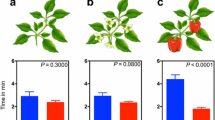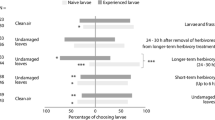Abstract
We compared the attractiveness of a mixture of cis-3-hexen-1-ol, cis-3-hexenyl acetate, and methyl salicylate (MeSA), and of each of these compounds singly, to a predacious ladybird beetle, Stethorus punctum picipes (Casey), to make it clear whether mixture of several volatiles may attract more natural enemies at different spatial scales. In an olfactometer experiment, S. p. picipes females were attracted to the volatile mixture, but not to single volatiles. Male S. p. picipes were not attracted to the mixture. In a small-scale open-field test using sticky cards, S. p. picipes were attracted to the volatile mixture and to MeSA alone. In a vineyard trapping test, significantly more S. p. picipes were trapped on sticky cards baited with a mixture of volatiles than on single-volatile-baited cards.




Similar content being viewed by others
References
Allison JD, Hare DJ (2009) Learned and naïve natural enemy responses and the interpretation of volatile organic compounds as cues or signals. New Phytol 184:768–782
Ament K, Krasikov V, Allmann S, Rep M, Takken FLW, Schuurink RC (2010) Methyl salicylate production in tomato affects biotic interactions. Plant J 62:124–134
Bolter CJ, Dicke M, Van Loon JJA, Visser JH, Posthumus MA (1997) Attraction of Colorado potato beetle to herbivore-damaged plants during herbivory and after its termination. J Chem Ecol 23:1003–1023
Chen L, Fadamiro HY (2007) Differential electroantennogram response of females and males of two parasitoid species to host-related green leaf volatiles and inducible compounds. Bull Entomol Res 97:515–522
D’Alessandro M, Turlings TCJ (2006) Advances and challenges in the identification of volatiles that mediate interactions among plants and arthropods. Analyst 131:24–32
De Boer JG, Dicke M (2004) Experience with methyl salicylate affects behavioural responses of a predatory mite to blends of herbivore-induced plant volatiles. Entomol Exp Appl 110:181–189
De Moraes CM, Lewis WJ, Pare PW, Alborn HT, Tumlinson JH (1998) Herbivore-infested plants selectively attract parasitoids. Nature 393:570–573
Dicke M, Sabelis MW, Takabayashi J, Bruin J, Posthumus MA (1990) Plant strategies of manipulating predator–prey interactions through allelochemicals: prospects for application in pest control. J Chem Ecol 16:3091–3118
Drukker B, Bruin J, Sabelis MW (2000) Anthocorid predators learn to associate herbivore-induced plant volatiles with presence or absence of prey. Physiol Entomol 36:260–256
Gols R, Bullock JM, Dicke M, Bukovinszky T, Harvey JA (2011) Smelling the wood from the trees: non-linear parasitoid responses to volatile attractants produced by wild and cultivated cabbage. J Chem Ecol 37:795–807
Gouinguene SP, Turlings TCJ (2002) The effects of abiotic factors on induced volatile emissions in corn plants. Plant Physiol 129:1296–1307
Ishiwari H, Suzuki T, Maeda T (2007) Essential compounds in herbivore-induced plant volatiles that attract the predatory mite Neoseiulus womersleyi. J Chem Ecol 33:1670–1681
James DG (2005) Further field evaluation of synthetic herbivore-induced plan volatiles as attractants for beneficial insects. J Chem Ecol 31:481–495
James DG, Grasswitz TR (2005) Synthetic herbivore-induced plant volatiles increase field captures of parasitic wasps. BioControl 50:871–880
James DG, Price TS (2004) Field-testing of methyl salicylate for recruitment and retention of beneficial insects in grapes and hops. J Chem Ecol 30:1613–1628
Jones VP, Steffan SA, Wiman NG, Horton DR, Miliczky E, Zhang Q-H, Baker CC (2011) Evaluation of herbivore-induced plant volatiles for monitoring green lacewings in Washington apple orchards. Biol Control 56:98–105
Kaplan I (2012) Attracting carnivorous arthropods with plant volatiles: The future of biocontrol or playing with fire? Biol Control 60:77–89
Khan ZR, James DG, Midega CAO, Pickett JA (2008) Chemical ecology and conservation biological control. BioControl 45:210–224
Kigathi R, Unsicker S, Reichelt M, Kesselmeier J, Gershenzon J, Weisser W (2009) Emission of volatile organic compounds after herbivory from Trifolium pratense (L.) under laboratory and field conditions. J Chem Ecol 35:1335–1348
Kugimiya S, Shimoda T, Wajnberg E, Uefune M, Takabayashi J (2010) Host-searching responses to herbivory-associated chemical information and patch use depend on mating status of female solitary parasitoid wasps. Ecol Entomol 35:279–286
Lee JC (2010) Effect of methyl salicylate-based lures on beneficial and pest arthropods in strawberry. Environ Entomol 39:653–660
Lewis WJ, Takasu K (1990) Use of learned odours by a parasitic wasp in accordance with host and food needs. Nature 348:635–636
Lou Y-G, Du M-H, Turlings TJ, Cheng J-A, Shan W-F (2005) Exogenous application of jasmonic acid induces volatile emissions in rice and enhances parasitism of Nilaparvata lugens eggs by the parasitoid Anagrus nilaparvatae. J Chem Ecol 31:1985–2002
Loughrin JH, Manukian A, Heath RR, Turlings TCJ, Tumlinson JH (1994) Diurnal cycle of emission of induced volatile terpenoids by herbivore-injured cotton plants. PNAS 91:11836–11840
Maeda T, Liu Y, Ishiwari H, Shimoda T (2006) Conditioned olfactory responses of a predatory mite, Neoseiulus womersleyi, to volatiles from prey-infested plants. Entomol Exp Appl 121:167–175
Mallinger RE, Hogg DB, Gratton C (2011) Methyl salicylate attracts natural enemies and reduces populations of soybean aphids (Hemiptera: Aphididae) in soybean agroecosystems. J Econ Entomol 104:115–124
Mumm R, Dicke M (2010) Variation in natural plant products and the attraction of bodyguards involved in indirect plant defense. Can J Zool 88:628–667
Orre GUS, Wratten SD, Jonsson M, Hale RJ (2010) Effects of an herbivore-induced plant volatile on arthropods from three trophic levels in brassicas. Biol Control 53:62–67
Pareja M, Mohib A, Birkett MA, Dufour S, Glinwood RT (2009) Multivariate statistics coupled to generalized linear models reveal complex use of chemical cues by a parasitoid. Anim Behav 77:901–909
Pichersky E, Gershenzon J (2002) The formation and function of plant volatiles: perfumes for pollinator attraction and defense. Curr Opin Plant Biol 5:237–243
Rodriguez-Saona C, Kaplan I, Braasch J, Chinnasamy D, Williams L (2011) Field responses of predaceous arthropods to methyl salicylate: A meta-analysis and case study in cranberries. Biol Control 59:294–303
Schiestl FP (2010) The evolution of floral scent and insect chemical communication. Ecol Lett 13:643–656
Schmelz EA, Alborn HT, Engelberth J, Tumlinson JH (2003) Nitrogen deficiency increases volicitin-induced volatile emission, jasmonic acid accumulation, and ethylene sensitivity in maize. Plant Physiol 133:295–306
Staudt M, Jackson B, El-Aouni H, Buatois B, Lacroze J-P, Poëssel J-L, Sauge M-H (2010) Volatile organic compound emissions induced by the aphid Myzus persicae differ among resistant and susceptible peach cultivars and a wild relative. Tree Physiol 30:1320–1334
Takabayashi J, Dicke M, Posthumus MA (1994) Volatile herbivore-induced terpenoids in plant-mite interactions: variation caused by biotic and abiotic factors. J Chem Ecol 20:1329–1354
Tóth M, Szentkirályi F, Vuts J, Letardi A, Tabilio M, Jaastad G, Knudsen G (2009) Optimization of a phenylacetaldehyde-based attractant for common green lacewings (Chrysoperla carnea s.l.). J Chem Ecol 35:449–458
Turlings TCJ, Ton J (2006) Exploiting scents of distress: the prospect of manipulating herbivore-induced plant odours to enhance the control of agricultural pests. Curr Opin Plant Biol 9:421–427
Turlings TCJ, Wäkers FL, Vet LEM, Lewis WJ, Tumlinson JH (1993) Learning of host-finding cues by Hymenopterous parasitoids. In: Papaj DR et al (eds) Insect learning. Chapman and Hall, New York, pp 51–78
Turlings TCJ, Loughrin JH, McCall PJ, Rose USR, Lewis WJ, Tumlinson JH (1995) How caterpillar-damaged plants protect themselves by attracting parasitic wasps. PNAS 92:4169–4174
Van Den Boom CE, Van Beek TA, Posthumus MA, De Groot A, Dicke M (2004) Qualitative and quantitative variation among volatile profiles induced by Tetranychus urticae feeding on plants from various families. J Chem Ecol 30:69–89
Yu H, Zhang Y, Wu K, Gao XW, Guo YY (2008) Field-testing of synthetic herbivore-induced plant volatiles as attractants for beneficial insects. Environ Entomol 37:1410–1415
Zhang Q-H, Schneidmiller R, Hoover D, Young K, Welshons D, Margaryan A, Aldrich J, Chauhan K (2006a) Male-produced pheromone of the green lacewing, Chrysopa nigricornis. J Chem Ecol 32:2163–2176
Zhang Q-H, Sheng M, Chen G, Aldrich J, Chauhan K (2006b) Iridodial: a powerful attractant for the green lacewing, Chrysopa septempunctata (Neuroptera: Chrysopidae). Naturwissenschaften 93:461–465
Zhu J, Park K (2005) Methyl salicylate, a soybean aphid-induced plant volatile attractive to the predator Coccinella septempunctata. J Chem Ecol 31:1733–1746
Acknowledgment
We thank Ms. Deborah T. Brooks in Washington State University, Irrigated Agriculture Research and Extension Center, for valuable information on S. p. picipes and other insects.
Author information
Authors and Affiliations
Corresponding author
Rights and permissions
About this article
Cite this article
Maeda, T., Kishimoto, H., Wright, L.C. et al. Mixture of Synthetic Herbivore-induced Plant Volatiles Attracts More Stethorus punctum picipes (Casey) (Coleoptera: Coccinellidae) than a Single Volatile. J Insect Behav 28, 126–137 (2015). https://doi.org/10.1007/s10905-015-9489-1
Revised:
Accepted:
Published:
Issue Date:
DOI: https://doi.org/10.1007/s10905-015-9489-1




